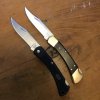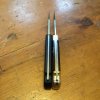Wowbagger
Gold Member
- Joined
- Sep 20, 2015
- Messages
- 8,036
The handle is made out of glass filled Nylon.
I hope this helps.
Say no more ! ! !
That's all I needed to know. Great stuff !
(after all my gushing about the Buck.com . . . might want to add that on the handle material line.
Probably sell more knives to those like me who are not filled in on Buck in the past)
I have a 110 with the finger grooves I bought new in the early '80s.
Funny thing, I keep expecting other knife handles to be that perfectly shaped and I've even modded handles to be more like the 110. . . . . I just realized that this past winter . . .
To make my grail "the way I wanted it" I cut thick KreyEx handles off a fixed blade and put them on the Ti Framed flipper just to get what I was searching for. Then I carried the 110 for a few weeks this winter after it was on the dresser for years and years and went
OH !
That's what I've been searching for.
Hahaha
Hard to improve on, or go without, perfection once I've experienced it. I'm looking forward to the lightness with texture. That'll be just TOO sweet.




